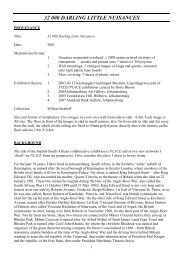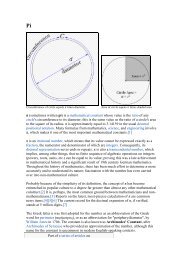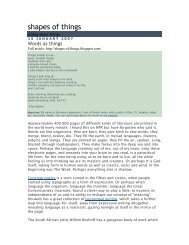Willem Boshoff Marvellous Art Musings.pdf
Willem Boshoff Marvellous Art Musings.pdf
Willem Boshoff Marvellous Art Musings.pdf
Create successful ePaper yourself
Turn your PDF publications into a flip-book with our unique Google optimized e-Paper software.
<strong>Marvellous</strong> <strong>Art</strong> <strong>Musings</strong><br />
WILLEM BOSHOFF: THE WORD ACCORDING TO BIG DRUID<br />
knowing through seeing…<br />
Posted on June 3, 2010 by marvellousartmusings<br />
‘It is only through seeing that one can know: Druids like artists must see in order to know.<br />
It is through art that one learns first to look and then to see. It is important to recognise<br />
that it is only once you can see that you can know. And it is by truly seeing that you can<br />
think intuitively. I have found the words for this knowing, Gnosis or Gnostic.’ <strong>Willem</strong><br />
<strong>Boshoff</strong>, 9 July 2009<br />
<strong>Willem</strong> <strong>Boshoff</strong>, Garden of Words III, 2006/9 (Source Goodman Gallery)<br />
Occasionally one recognises the weight of a moment and you know that you are<br />
experiencing something extraordinary. One such instance for me was when South African<br />
artist <strong>Willem</strong> <strong>Boshoff</strong> addressed a handful of art enthusiasts as part of a corporations’ art<br />
education programme.<br />
<strong>Boshoff</strong>’s tangible presence seemed to dwarf the meeting room. He was clearly in the<br />
moment yet it is unclear whether he is entirely of this realm or of another Zeitgeist. Does<br />
the heavily bearded man[1], with the deep ‘knowing’ eyes encapsulate prehistoric man,<br />
the Druids or the early Dutch settlers to South Africa, or something of all of these<br />
personae, as he slumps his broad shoulders over his large frame? As a self-proclaimed<br />
Druid, his path to self-realisation has been a long and arduous one.<br />
In the calm and measured voice of an oracle he took his awestruck audience with him on<br />
his journey of religion, an obsessive search to locate the quintessential meaning of his life,
of words, the human experience, his urge to collect things and his deep- seated interest in<br />
and bond with the natural world. These obsessions have been translated into a<br />
commendable body of artworks shown at home in South Africa and in major international<br />
art centres, not to mention the series of extraordinary dictionaries he has published.<br />
<strong>Boshoff</strong> has always been driven to work excessively hard. Fierce ambition and devout<br />
religion characterised his early years. In his twenties he spread God’s word as a street<br />
preacher, taught and practiced as an artist and wrote an anthology of poetry. He refused<br />
to exhibit his artwork until he was 30, and then only when he was invited to show at the<br />
Johannesburg <strong>Art</strong> Gallery as a guest artist. His decision to delay the public showing of his<br />
work was partly based on religious grounds (Christ’s ministry began after he had turned<br />
30) and partly on the belief that an artist needs to mature somewhat before exhibiting his<br />
or her work.<br />
The first exhibition of <strong>Boshoff</strong>’s work at the Johannesburg <strong>Art</strong> Gallery opened on 12<br />
September 1981, the artist’s 30th birthday. He exhibited a number of major works,<br />
including TAFELBOEK (1975-1979), KASBOEK (1981), KUBUS (1976 – 1982),<br />
STOKKIESDRAAI (1980), VERSKEUR (1979), BANGBOEK (1978-1981), SKYNBORD (1977-<br />
1980), BLOKKIESRAAILSEL (1974-1980) and SANDKOEVERT (undated).[2]<br />
<strong>Boshoff</strong> admits to an inherent nervousness, a distrust of most things, especially electronic<br />
equipment, and is consumed by compulsive attention to detail. He counters his<br />
nervousness by always being exceedingly well prepared for anything and everything. He<br />
relates how as a teacher and lecturer he was so ‘very nervous’ that he prepared his<br />
lessons with fanatical attention to detail, so much so that he even anticipated questions<br />
and prepared answers in advance.<br />
His mistrust of technology was validated at our talk when the borrowed laptop intended<br />
to project his carefully prepared presentation on a screen failed to work. His own more<br />
trusted and reliable equipment had yet to arrive from<br />
He inhabited, worked and slept (sporadically) in a specially constructed cubicle for seven<br />
days and nights.<br />
But back in the meeting room it would seem fortuitous that without the visual material to<br />
accompany the discussion the focus centred on the man, his life, his words and worldview<br />
– and made for a particularly interesting encounter with one of South Africa’s foremost<br />
artists. Also there is the promise of another meeting at a later stage to take the discussion<br />
further and to show projected visuals of some of his remarkable body of work.<br />
<strong>Boshoff</strong> told us that at the age of 36 he was fanatically fit, to the extent that he<br />
participated in numerous marathons. But then he was suddenly and inexplicably struck<br />
down with a debilitating illness. For the next twenty years he endured unimaginable pain<br />
and discomfort as the result of a condition for which there was no relief, no explanation<br />
and therefore no cure. He sighed with resignation as he said, ‘It was miserable’. Four<br />
years ago, in extreme pain, unable to walk and close to death, he was for the first time<br />
correctly diagnosed and treated for lead poisoning. He contracted this affliction in the
mid 1980s after resorting to collecting and restoring old fireplaces for sale, working on an<br />
old farm in Doornfontein, south of Johannesburg. He was 33, had just divorced his first<br />
wife and had bills to pay. Working without a mask, he inadvertently inhaled dangerously<br />
high levels of lead present in the paint he used.<br />
<strong>Willem</strong> <strong>Boshoff</strong>, Big Druid in his Cubicle, 2009, <strong>Art</strong> Basel, Switzerland (Goodman Gallery)<br />
Today one discerns in <strong>Boshoff</strong> a deep-rooted realisation of the enormity of having been<br />
given a second lease of life. There is something about the expression in his eyes and his<br />
demeanour that hint at the incredulity of having survived a life threatening ordeal. And<br />
then, of course, there was his immense relief of having been freed from constant physical<br />
and mental anguish, even though his health remains comprised as some damage is<br />
irreversible.<br />
Before being correctly diagnosed, <strong>Boshoff</strong> was unable to sleep, forcing him into a<br />
‘particularly strange and unusual lifestyle’, ‘not unlike that of a reclusive monk’, he says.<br />
Constant toil was one of the only ways of coping with his severe pain and discomfort. He<br />
found some measure of respite in an unremitting working regimen. This, he says, also<br />
accounts for his exceptionally prolific body of work. He still leads the life of a loner, ‘a<br />
strange and meditative life’ in spite of having remarried in 1987 and being the father of<br />
four children.<br />
His persistent compulsion to drill down into the core of all things takes on many forms of
expression – including music. <strong>Boshoff</strong> told us that he has even written allegorical music<br />
scores. His interest in music spans medieval and early music, as well as avant garde<br />
music.[3] Yet one of his primary obsessions remains a fascination with words, their origins<br />
and meaning. He is inordinately drawn to uncovering the essence of arcane and difficult<br />
words. He grapples with individual words until he can define their quintessential<br />
meaning, until ‘I can give obscure words a face’, he says.<br />
<strong>Boshoff</strong> discovered the true value and power of language and words and how they can<br />
include, exclude or alienate others. He became aware of how a good command of<br />
language can bestow dominion over others less fluent. This was particularly evident when<br />
he, as an Afrikaans speaker, began teaching at English language schools in the 1970s.[4] ‘I<br />
became aware of the power relationship of words and how words can either franchise or<br />
disenfranchise people’, he explained. He also came to understand that ‘there is no<br />
monopoly on knowledge and that knowledge is not exclusively the domain of the<br />
intelligencia.’<br />
<strong>Boshoff</strong> acquired a set of word-building tape recordings which he played continuously in<br />
his car – and he learnt the most difficult words by heart. He kept up this pursuit all the<br />
while keeping it a secret until he had a very real and deep-seated understanding of<br />
particularly obscure words. He spent relentless hours uncovering 10,000 obscure words<br />
which he defined in his own words and then memorised. At a particularly painful period<br />
during his illness he spend vast amounts of time going through the over 200 dictionaries<br />
he collected over time. He has over the years compiled and published a number of<br />
dictionaries.[5]<br />
While teaching, he carefully chose the moment to reveal his incredible knowledge of the<br />
English language and the origins of words, often Greek. He would then write difficult<br />
words on the blackboard and challenge his fellow teachers or students to come up with<br />
the meaning of the word. One day the word ‘elements’ came up in class. He put up the<br />
word ‘Maetic’ and no-one knew what it meant. <strong>Boshoff</strong> could not only explain the full<br />
meaning of the word and elaborate on its origins, the root of the word – and apply the<br />
word. He spoke of how the Maetic method was used by Socrates to bring out the truth.<br />
<strong>Boshoff</strong> felt empowered by this experience giving credence to the notion that individuals<br />
are empowered and emboldened by language.<br />
Much of <strong>Boshoff</strong>’s art gives visual expression to concepts- as-words. Words exist because<br />
they describe something of the human condition, human thought and activity. With his<br />
dictionaries and with his art he sets about interpreting and giving weight and meaning to<br />
these concepts.<br />
The power of words and the powerlessness of those who do not have easy access to<br />
words is the idea behind <strong>Boshoff</strong>’s BLIND ALPHABET (1991 – 2000), a highlight at<br />
Johannesburg’s first biennale in 1995. At first he wanted to build 10 walls, each with 1000<br />
bricks with a plaque with a different word of the English language on each brick – and<br />
perhaps each of the other 10 official languages in South Africa. The flummoxed viewer<br />
would be at a loss to understand the words, would feel disempowered and<br />
disenfranchised. This ambitious work has yet to be realised, but <strong>Boshoff</strong> maintains he
intends to bring this daunting project to fulfilment – and it remains a work in progress.[6]<br />
But BLIND ALPHABET was completed and exhibited at the Johannesburg <strong>Art</strong> Gallery,<br />
drawing in the crowds and receiving critical acclaim. <strong>Boshoff</strong> explained how he wanted to<br />
make sighted people experience blindness by not being able to access the blind alphabet.<br />
This work forces sighted individuals – who take their sight for granted – to call on the<br />
blind to read and explain the words. It is a reversal of roles, a reversal of experience. Blind<br />
people are typically excluded from experiencing art unless they request permission to<br />
‘see’ and touch works of art. Gallery staff may feel put upon, make their feelings known<br />
and leave the blind feeling disenfranchised. Sighted visitors were visibly moved by<br />
<strong>Boshoff</strong>f’s work, when they had some inkling of what it meant to be blind and<br />
disempowered and when they could eventually ‘see’ and experience what the artist had<br />
set out to achieve.<br />
One of <strong>Boshoff</strong>’s most enlightening moments of self-realisation was discovering his<br />
affiliation with Druids and similar creatures, although he was initially reluctant to go<br />
public with this discovery. He has always been profoundly drawn to trees and plants,<br />
leading to exhaustive botanical research. His fascination with wood and natural flora also<br />
evolved into an intensive study of Druids, Sangoma, Seers and ‘Sieners’ leading him to the<br />
Inyanga. There is an uncanny similarity between the European Druid, the South African<br />
Sangoma and the Inyanga, the ‘man of trees’ – and <strong>Boshoff</strong> himself.<br />
One of <strong>Boshoff</strong>’s most profound discoveries was that all true Druids have experienced<br />
near death – one more thing he has in common with these ‘cultural repositories of<br />
knowledge’. <strong>Boshoff</strong>’s study of Greek further elucidated the origins and practices of the<br />
Druid and their extraordinary close association with trees (particularly the oak) and their<br />
ability to heal using plants. Druids also have ‘accomplices’ or ‘side kicks’ (wood or tree<br />
nymphs) to assist them with their tasks. The sheer scale and weight of <strong>Boshoff</strong>’s work<br />
requires him to employ assistants to help him with his immense sculptures.<br />
The artist was born into world imbued with wood, his father was a carpenter and the<br />
artist often assisted the older <strong>Boshoff</strong> in his workshop. <strong>Boshoff</strong> has never veered too far<br />
from his close relationship with wood fashioning many a complex and multilayered<br />
sculpture out of this material. He has carved, crafted and coaxed out of wood many<br />
extraordinary works, often making reference to books and words, such as the remarkable<br />
TAFELBOOK (1975-1979). Yet, he says, he could never find exactly what he was striving for<br />
until he located his close affiliation to the Druids.<br />
In <strong>Boshoff</strong>’s view, the artist like the Druid must be exposed to nature. ‘Just like the fine<br />
artist the Druid must train him or herself to look. Both must be visually aware to be able<br />
to make social deductions’, <strong>Boshoff</strong> explained. Like the artists, the Druid has to establish<br />
where the individual fits into a social context, and how power relationships play out. How<br />
power relationships play out fascinates <strong>Boshoff</strong> and he is acutely aware of how social<br />
deductions can be made by closely observing the relationship between, for example, a<br />
man and his horse and how a man treats his horse – or how ‘a man treats his woman’, he<br />
added.
Like the Druid, <strong>Boshoff</strong> incessantly walks and he sees things, he is ‘omnivagrant’. He, like a<br />
Druid, walks where others do not venture and he walks endlessly. This, <strong>Boshoff</strong> said, is<br />
one of the ways in which he sees the things that he applies to his art. <strong>Boshoff</strong> also<br />
habitually meditates. He describes it as sliding across a beautiful pool of water, of being in<br />
a space where he need only focus on his breathing, as if he no longer feels the need to be<br />
anywhere at all. It is also a place where he no longer feels tired. ‘It is like floating or<br />
walking on clouds – or on water’, he added wryly.<br />
In view of <strong>Boshoff</strong>’s previous extreme immersion in religion one may well wonder how his<br />
illness and journey of self-discovery has influenced his attitude towards God. He<br />
explained that he responds to the question ‘Do you believe in God?’ with two answers:<br />
‘Yes I do’ and “No I don’t.’ It all depends, he says, on what is meant by the question. He<br />
raised his hands and moved them from side to side as he asked: ‘Does it mean this, or<br />
does it mean that?’ The point is what exactly is meant by the question?<br />
For <strong>Boshoff</strong> it is very important to show his work outside in the open air, and for art not<br />
always only to be exhibited in what he refers to ‘refrigerated air conditioned spaces<br />
encircled by walls’. ‘I love to have art where the wind blows, where you can feel the wind<br />
on your skin,’ he says. He spoke with great passion of his outdoor sculptures, like Garden<br />
of Words III (2006) comprising 15 000 ‘flowers’ inspired by a visit to a World War I<br />
cemetery in Flanders. The Latin name of each flower is printed on a white ‘handkerchief’,<br />
held in a red cup and planted in the ground in blocks of immaculately straight rows.<br />
<strong>Boshoff</strong>’s massive ‘words on polished (once) molten black rock’ form a large and<br />
important component of his work. Circle of Knowledge (2001) installed at the University<br />
of Johannesburg comprises eleven granite rocks, carved to resemble large black pebbles.<br />
Pebbles, psephos in Greek, were used in ancient times to cast a vote. The Romans used<br />
stones to do maths and arithmetic. This theme recurs in a commission done for the<br />
Johannesburg head office of BHP-Billiton. This work called Psephos (1994-1995) is made<br />
up of nine panels with 18 pebble types collected from the nine provinces of South Africa.<br />
The pebbles are positioned to form nine crosses, the mark conventionally made to cast a<br />
vote and refers to the first democratic election in South Africa.<br />
At a 2009 exhibition called ‘Sources – Contemporary Sculpture in the Landscape’ shown in<br />
the sculpture garden of the Nirox Foundation appropriately situated in the Cradle of<br />
Humankind, west of Johannesburg, <strong>Boshoff</strong> exhibited Children of the Stars: Big B (2009)<br />
and Children of the Stars: little B (2009). These huge stone sculptures are created from<br />
the most impenetrable black granite in South Africa. With these works <strong>Boshoff</strong> pays<br />
homage to Archimedes. On the two halves he has ‘sandblasted concentric snippets of<br />
unresolved mathematical philosophy – ripples when a pebble falls in a pool’.[7] <strong>Boshoff</strong><br />
writes,<br />
‘My favourite moment in this work occurs when it rains – Archimedes taking a bath. The<br />
raindrops soak up the grey texts so that they vanish into the black of the overall granite,<br />
their life taken. Yet, when the sun shines on the piece, the words dry out and “Eureka!”<br />
the texts resurface miraculously – nothing skills them. The sword sadly intrudes, but<br />
somehow the chalk remains indelible.’[8]
<strong>Willem</strong> <strong>Boshoff</strong>, Morabaraba Stone (detail), 2009, Belfast black granite with sandblasted text (Source<br />
Goodman Gallery)<br />
<strong>Boshoff</strong>’s Morabaraba Stone (2009) exhibited at the same outdoor venue has cast in<br />
‘stone for eternity, probably the oldest game in the world and played throughout<br />
Africa.’[9]
<strong>Willem</strong> <strong>Boshoff</strong>, Morabaraba Stone, 2009 (Source Goodman Gallery)<br />
At the time of the talk, <strong>Boshoff</strong> was working on Penelope’s Distaff (2009), shaped from<br />
hard black rock in the form of a four and half meter spindle ‘or rod for the winding of yarn<br />
to be spun’. Lines from Penelope’s story taken from the ancient Greek and Latin text are<br />
wound around the spindle. This work formed an integral part of Penelope and the<br />
Cosmos, the inaugural exhibition – with fellow artist, Karel Nel – in the newly created<br />
contemporary art space, Circa, in Johannesburg, November 2009.<br />
<strong>Boshoff</strong> based this work on the legend of Penelope who, following the untimely death of<br />
her father-in-law, was left at home by Odysseus, her newly-wed husband, who went off<br />
to war. During his time away the exceptionally beautiful Penelope began to weave a<br />
funeral shroud, a task traditionally associated almost entirely with women. It is recorded<br />
that during her husband’s absence she had no less that 108 suitors trying to win her<br />
affection. But she proclaimed that she would not entertain their overtures until the<br />
shroud was complete. As time passed and her husband had still not returned she would<br />
unravel the cloth so as to postpone its completion and in so doing keep her many ardent<br />
admirers at bay. <strong>Boshoff</strong>’s multilayered tribute to Penelope revolves not so much around
what she was doing, says <strong>Boshoff</strong>, but what Penelope and other women are thinking<br />
when they are alone, their sadness and their longing.<br />
<strong>Willem</strong> <strong>Boshoff</strong>’s deep rooted search to uncover the meaning of words and things, and to<br />
translate them into multilayered conceptually works, fastidiously executed has given rise<br />
to a body of profound and challenging works – and earned him local and international<br />
recognition.<br />
For those of us who gathered around the meeting table to hear the word according to Big<br />
Druid, this was no ordinary Thursday – and <strong>Boshoff</strong> certainly is no ordinary man.<br />
<strong>Willem</strong> <strong>Boshoff</strong>’s was invited to speak at Sasol Limited’s head office in Rosebank,<br />
Johannesburg as part of an art education programme.<br />
[1] <strong>Boshoff</strong> points to this word: pogonotrophy Greek: to not cut one’s beard<br />
[2] Siebrits, W (2007), p. 17 <strong>Willem</strong> <strong>Boshoff</strong>: word forms and language shapes 1975 –<br />
2007<br />
[3]Siebrits, W (2007), p. 116. <strong>Willem</strong> <strong>Boshoff</strong>: word forms and language shapes 1975 –<br />
2007<br />
[4] 1973-1976 part time teacher, Jeppe Boys’ High and Johannesburg College for<br />
Advanced Technical Education – Languages and Fine art. 1975-77 teacher, Parktown Boys’<br />
High School – Afrikaans, Religious Instruction and Fine <strong>Art</strong>. Source: Siebrits, W (2007), p.<br />
116.<br />
[5] 1977 Dictionary of Colour; others include Dictionary of Manias and Phobias; Dictionary<br />
of Morphology; Dictionary of –ologies and –isms; Dictionary of Beasts and Demons;<br />
Dictionary of Winds, Dictionary of Obscure Financial Terms; Places Mother Might not<br />
Approve of; Unmentionabilia; Red Names; 2004 completes the Oh No! Dictionary;<br />
completes in 1999 Dictionary of perplexing English – a ten year project, using research<br />
from 200 dictionaries including the 25 volumes of the Oxford English Dictionary; 2000<br />
compiles Beyond the Epiglottis, a dictionary of extraordinary terms in rhetoric. Source:<br />
Siebrits, W (2007), p. 116. <strong>Willem</strong> <strong>Boshoff</strong>: word forms and language shapes 1975 – 2007<br />
[6] Blind Walls (1988 – 97), a post modern dictionary for the 11 official languages of South<br />
Africa, consisting of 10 000 arcane worlds on 10 obstacle walls – work in progress. Source<br />
Siebrits, W (2007), p. 116. <strong>Willem</strong> <strong>Boshoff</strong>: word forms and language shapes 1975 – 2007.<br />
[7] <strong>Boshoff</strong>, W. (2009), pg. 22 Sources – Contemporary Sculpture in the Landscape. Nirox<br />
Foundation and Goodman Gallery. Johannesburg<br />
[8] As above<br />
[9] As above
About marvellousartmusings<br />
<strong>Marvellous</strong> <strong>Art</strong> <strong>Musings</strong> interactively muses on a personal journey in the field of<br />
twentieth century and contemporary South African art, and showcases the vibrant South<br />
African art scene and more ... <strong>Marvellous</strong> <strong>Art</strong> provides art consulting, curating and writing<br />
services








